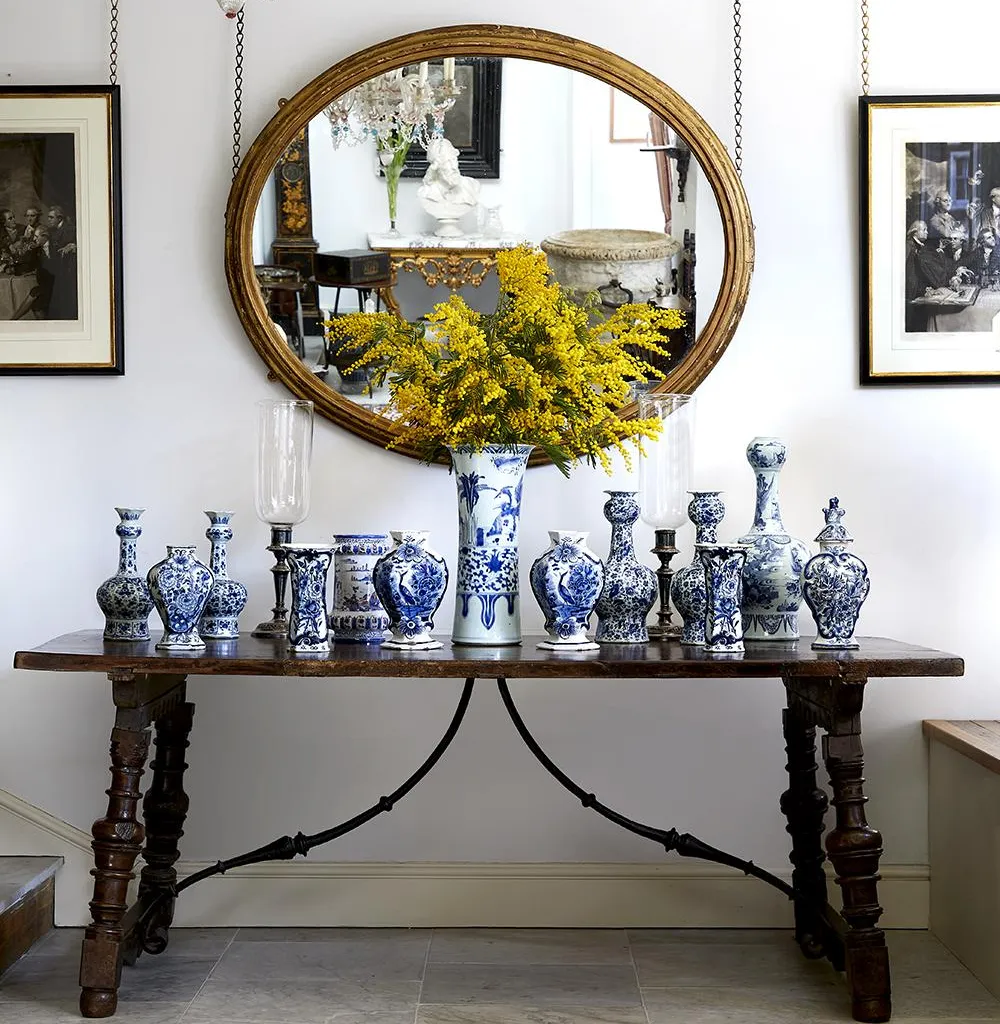‘I can’t define my taste. It’s an instinct; I don’t think about it. You see something you haven’t seen before, and you just have a thirst for it,’ Robert Kime says modestly of a keen-eyed talent that has enabled him to create a plethora of highly original yet timeless interiors, over a career spanning six decades.
Characterised by objects that are often whimsical and historically intriguing, invariably enriched by variously patterned textiles, Robert’s interiors are testimony to an aesthetic judgement honed by instinct and a lifetime of collecting.
The Prince of Wales, one of his illustrious clients, described his work as ‘a process of genius’, after Robert designed the interiors at Highgrove and Clarence House for him. ‘It is all in the minute attention to detail and the subtle choice of colour and marvellously original materials,’ he went on.
Yet despite such accolades, Robert remains disarmingly low-key. If asked to describe his working methods, he says they are ‘pretty random’, with ‘comfort and ease’ an uppermost consideration. ‘It’s where things fit that makes them beautiful. I don’t know what I do; it does itself.’
Brought up in Hampshire, Robert Kime’s interest in collecting and interiors started in his childhood, when he became enthralled by history and started collecting old Roman and English coins. ‘I didn’t like living in my parents’ house, but there was a shed in the garden full of lots of stuff they didn’t use. I used to hang out there and make rooms out of the rugs and curtains and all the furniture,’ he recalls.

History still captivated him by the time he left school, aged 16, with four A Levels. After travelling in France and Italy and working on archaeological sites in Greece and Israel for 18 months, he went to Worcester College, Oxford, to study medieval history.
While he was there, his life underwent seismic disruption as his parents’ marriage fell apart. ‘From being well-to-do, quite suddenly we had nothing. I had to leave Oxford to look after my mother.’ Kime was still a teenager, but it fell to him to sell the family house and the furniture, ‘to raise money fast’.
He remembers it as a painful process in which he learned an enormous amount about antiques and the trade. ‘I just pressed on and did it. I made a lot of mistakes. Things that I thought were ordinary turned out to be worth a fortune.’
A year later, cajoled by his tutor, Kime returned to Oxford. He explained that he would now have to deal, alongside his studies, to pay his way. ‘I had a very good time, selling Japanese prints to the Ashmolean, and Iznik pottery to the master’s wife. It was easy to get stock. I took Thursdays off to go on the bus to Burford. On the way, there were five or six shops you could call in at.’
A favourite hunting ground was a shop belonging to famous dealer Roger Warner. ‘I used to go there with my girlfriend, and she’d buy wonderful silk dresses. Philip Astley-Jones was his assistant – an amazing man, and we had great times together.’

After leaving Oxford, Robert met the scientist Miriam Rothschild, who enlisted him to help her sell French furniture crammed in her attics at Ashton Wold, Northamptonshire, and who later helped him establish his own dealership. ‘I loved trading; I didn’t make much, but sometimes I did. To begin with, it was very precarious; from one chaotic moment to the next,’ he recalls.
As his reputation grew, clients complemented him on the way objects were displayed in his home and his shop, and asked for his help. And so the interior design business took shape.
Over the years, Robert’s eclectic taste has changed little. ‘I don’t have a particular interest in having everything in the same period. You have to mix it up. You can have a very expensive thing and a very cheap thing, and you put them together to make both of them look better. And then if you multiply that, you get an extraordinary result.’
When he works for clients, Robert takes a gentle approach. ‘I ask them how they want it and always start with a carpet. I don’t think of colours for a room until the last moment. It’s the least interesting bit to me, and it’s the last thing to do.’
In his own home, he still treasures objects bought many years ago: ‘Sometimes I go off things, but not that often, although my flat is full of stuff and I must occasionally get rid of things. I’ve got a green Chinese wallpaper screen that cost £8 and came from Erddig house; it’s a marvellous thing. But seeing something interesting is what excites me.
I bought a beautiful Palladian mirror recently; it’s painted, with its original plate glass – very exciting. I’ll have to take down a carpet and move everything around to accommodate it.’
Travel has always been a source of enjoyment, as well as unusual objects. ‘I can’t wait to go to Turkey – I used to go three or four times a year. I also buy a lot in Egypt, and I love the antiques fair in Parma, Italy.’ He still finds dealing as exciting as he always has.
‘It’s interesting what people chuck out, and it’s often the wrong thing.’ At present, Robert says rugs are undervalued: ‘I bought a wonderful 17th-century Ushak rug the other day, really for nothing.’ And the other great thing about rugs? ‘If you can’t afford pictures, you can put them on the wall.’
